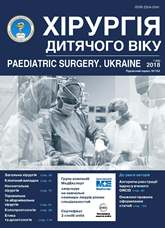Results of esophagoplasty in children with corrosive strictures of esophagus
DOI:
https://doi.org/10.15574/PS.2018.58.90Keywords:
children, esophageal burns, esophagocoloplastyAbstract
Objective – to analyse the results of esophagoplasty in children with corrosive strictures of esophagus.Material and methods. In total 25 children with complications of chemical and electrochemical injuries of the esophagus were operated from February 2000 till April 2017 in the Republican Scientific and Practical Centre of Pediatric Surgery in Minsk. As a corrosive substance in 17 cases it was alkali with high pH, in one case – an acid. The electrochemical burn was caused by an active battery with a voltage of 3 V, 2 cm in diameter, swallowed and stuck in the physiologic esophageal narrowing.
Results. The indications for esophagoplasty in patients with chemical burn of the esophagus were the failure of gullet bougienage and complications during the procedure as well as esophageal wall necrosis and rejection (esophageal wall defect) with the development of mediastinitis in children with an electrochemical burn of the esophagus. As a plastic material, the part of transverse colon from the hepatic angle to colon descendens was predominantly used. The graft in 60% of patients was pulled up through the anterior mediastinum. The long-term outcomes of the esophagoplasty were studied in 22 children over a period from 6 months up to 15 years 10 months after its completion. According to the physical examination (complaints, clinical, radiological and endoscopic examinations), good outcome after the operation was observed in 14 (64%) children, satisfactory result – in 7 (32%) patients, unsatisfactory – in 1 (4%) case. There were no lethal outcomes.
Conclusions. The most dangerous complication of conservative treatment of the corrosive esophageal stricture (CES) is perforation and rupture with the development of mediastinitis. In case of the esophageal perforation, the operation of choice is an emergency separation of the esophagus with gastrostomy and cervical esophagostomy. Treatment of CES by endoscopic bougienage and dilatation should be conducted for no more than two years. Bypass esophagocoloplasty is the operation of choice for patients with CES.
References
Averin V.I., Nesteruk L.N, i Grinevich Yu.M. (2011). Blizhayshie i otdalennyie rezultatyi ezofagokoloplastiki pri atrezii pischevoda u detey. Rossiyskiy vestnik detskoy hirurgii, anesteziologii i reanimatologii. 1: 34–39.
Averin V.I., Nesteruk L.N., Grinevich Yu.M. et al. (2013) Kachestvo zhizni patsientov posle plastiki pischevoda. Zdravoohranenie. 12: 67–76.
Averin V.I., Podgayskiy V.N., Nesteruk L.N. et al. (2012). Pervyiy opyit revaskulyarizatsii transplantata pri plastike pischevoda u detey v nestandartnyih situatsiyah. Novosti hirurgii. 1: 80–84.
Andrianov V.A., Chernookov A.I. et al. (2003). Plastika pischevoda tolstoy kishki u bolnyih s ozhogovyimi strikturami pischevoda. Hirurgiya. 7: 50–54.
Degtyar V.A., Barsuk A.M., Kaminskaya M.O. et al. (2017). Lechenie himicheskih ozhogov pischevoda u detey. Hirurgiya dityachogo viku. 3: 54–56.
Dzhafarov Ch.M., i Dzhafarov E.Ch. (2007). Blizhayshie i otdalennyie rezultatyi hirurgicheskogo lecheniya bolnyih s rubtsovyimi strikturami pischevoda posle himicheskogo ozhoga. Vestnik hirurgii. 5: 36–38.
Ivanov A.P., Miroshnnikov B.I., Yakunin S.I. et al. (2013). Ezofagoplastika pri sochetannom rubtsovom porazhenii pischevoda, gortanoglotki i trahei u detey. Vestnik hirurgii. 5: 59–65.
Kozhevnikov M.A. (2006). Hirurgicheskoe lechenie rubtsovyih suzheniy pischevoda u lits, zabolevshih v detskom vozraste, i otsenka ego effektivnosti. Irkutsk.
Razumovskiy A.Yu. (1987). Antireflyuksnaya zaschita transplantata pri koloezofagoplastike. Moskva.
Razumovskiy A.Yu., Geraskin A.V., Obyidennova R.V., Kulikova N.V. (2012). Lechenie himicheskih ozhogov pischevoda u detey. Hirurgiya. 1: 43–48.
Haritonova A.Yu., Gorelik A.L., Kovalenko M.I. (2017). Sluchay dlitelnogo nahozhdeniya elektricheskoy byitovoy batareyki v pischevode. Detskaya hirurgiya. 4: 220–222.
Hasyanzyanov A.K., Kistanova E.F., Santimov P.V. (2009). Koloezofagoplastika u rebenka, perenesshego himicheskiy ozhog pischevoda schelochyu. Detskaya hirurgiya. 6: 53–54.
Chepurnoy G.I., Katsupeev V.B., Rozin B.G. et al. (2006). Pischevodno-tolstokishechnyiy anastomoz na shee pri ezofagoplastike u detey. Detskaya hirurgiya. 5: 17–21.
Chernousov A.F., Bogopolskiy P.M., Kurbanov F.S. (2000). Hirurgiya pischevoda: rukovodstvo dlya vrachey. Moskva: Meditsina.
Guzzetta P.С., Randolph J.G. (1986). Antireflux cologastric anastomosis following colonic interposition for esophageal replacement. J Pediatr Surg. 21; 6: 1137–1138.
Downloads
Issue
Section
License
The policy of the Journal “PAEDIATRIC SURGERY. UKRAINE” is compatible with the vast majority of funders' of open access and self-archiving policies. The journal provides immediate open access route being convinced that everyone – not only scientists - can benefit from research results, and publishes articles exclusively under open access distribution, with a Creative Commons Attribution-Noncommercial 4.0 international license(СС BY-NC).
Authors transfer the copyright to the Journal “PAEDIATRIC SURGERY.UKRAINE” when the manuscript is accepted for publication. Authors declare that this manuscript has not been published nor is under simultaneous consideration for publication elsewhere. After publication, the articles become freely available on-line to the public.
Readers have the right to use, distribute, and reproduce articles in any medium, provided the articles and the journal are properly cited.
The use of published materials for commercial purposes is strongly prohibited.

